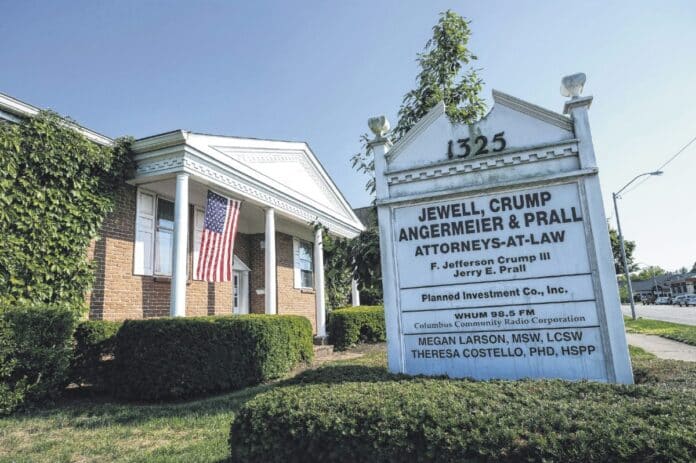
As one Columbus resident puts it, listening to Columbus’ community radio station WHUM is “like going to an antique mall and never knowing exactly what you will find.”
That’s how one fan describes the music variety on the station, which is celebrating its 15th anniversary this fall.
Since 2004, WHUM Radio (98.5 FM Columbus / 98.3 FM Seymour) has provided “a mix of music from all eras and most genres” in a commercial-free format.
Described as eclectic, this free-form style of programing is gaining in popularity, according to WHUM owners Bruce and Mitzi Quinn.
[sc:text-divider text-divider-title=”Story continues below gallery” ]Click here to purchase photos from this gallery
Strictly-formatted stations might have as few as 50 songs, while classic rock stations often have a playlist of about 600 songs. WHUM already had 3,000 songs when they first put their community radio station on the air in Columbus, Mitzi Quinn said. Today, the station boasts more than 10,000 songs in its digital library, she said.
“And we keep adding more,” she said.
Faithful listeners have been introduced to WHUM in a variety of ways. For example, Matt Battin of the Bicycle Station in Columbus said he recognized Bruce Quinn’s voice immediately while switching stations in his car. Several years earlier, Battin was a regular listener of Quinn’s station in Brownsburg, Battin said.
“I just stumbled across his voice, and I got to enjoy the good variety of music,” Battin said. “The fact they are commercial free is nice, as well as the community announcements they give.”
There never has been, nor ever will be, one radio station that suits everyone. So when a musical format such as WHUM’s follows up Doris Day’s 1944 “Sentimental Journey” with B.B. King’s “The Thrill Is Gone” from 1970, there’s bound to be some folks left scratching their heads.
But what confuses those people is exactly what attracts WHUM fans.
When songs from different eras and cultures are brought together, a listener begins to understand and appreciate how one style or genre impacts another genre over time, Bruce Quinn said.
That’s one reason why Bruce Quinn says he wants to feature all of these styles on his radio station.
“It doesn’t take long before you soon realize how these songs all evolved from each other,” Quinn said. “Our philosophy is that people are not one-dimensional, so why should a radio station be?”
On the road
As John Kocur of Columbus travels around the U.S. on behalf of the Indianapolis Motor Speedway (IMS Productions), he said he listens to WHUM regularly on the internet.
“It gives me a taste of home while I’m away,” Kocur said during a telephone interview from California. “The music is nothing like you’ll find anywhere else in the country.”
When he first came across WHUM years ago, Bartholomew County Zoning Officer Bill Klakamp said he didn’t understand all the different genres being brought together. But now, Klakamp says he believes the eclectic variety is the station’s main appeal.
“I feel like I’m expanding my horizons musically when I listen,” Klakamp said. “And by supporting WHUM, I feel I’m supporting the local arts.”
The radio station has such a variety of music that you are bound to come across something that fits your mood, Columbus resident John Heichelbech said. Describing himself as an amateur musician, Heichelbech says he learns something new every day from listening to the station.
And when asked what she likes about WHUM, retired educator Billie Mae Wintin of Seymour gave a one word reply — “everything.”
Another lesson that Quinn says he’s learned is that middle-aged or older people who have spent decades listening to the same type of music are often ready to hear something different.
“When they were young, listening to Mom and Dad’s music wasn’t cool,’ he said. “But now, their parents may be gone. And what was uncool back then — brings back fond remembrances and nostalgia,” Quinn said.
The polite pirate
Is there any type of music WHUM won’t play? The short answer is yes.
Loud guitar solos might be permitted at night, but not during regular business hours when WHUM is playing in businesses, Bruce Quinn said. WHUM also avoids overtly sexual lyrics, disrespectful attitudes towards women, or divisive attitudes that contribute to racism, he said.
“Broadcasters are supposed to have a touch of class,” Quinn said. “It’s not for me to (use vulgarities). We’re trying to make a difference with family-friendly and educational music.”
Those were the same morals Quinn displayed in the 1970s when he was known as “Bruce the Radio Pirate.” Quinn said he was broadcasting illegally to protest what he frequently describes as “cookie-cutter” radio formats.
After a Federal Communications Commission agent monitored Quinn’s illegal “Jolly Roger Radio” broadcast from Bloomington, Quinn and a few associates were arrested. However, his fine was limited to only $250. One reason quoted in news articles from the era was that Quinn avoided airing anything obscene or vulgar, which impressed federal authorities.
The arresting FCC agent eventually became a friend to Quinn, and showed him how to work the system to obtain legal license.
Quinn used that break to his advantage. Over the decades, Quinn would either own, manage or consult about 10 different commercial radio stations.
The sale of one station near Indianapolis in 2005 provided him with enough financial independence that the couple doesn’t have to rely on their station for income.
That independence also allows the couple to satisfy listeners and themselves, rather than advertisers, with their eclectic format, Bruce Quinn said.
Global presence
Since both Columbus and Seymour are broadcasting WHUM on a 100-watt signal, picking up the station in your car becomes more difficult when you drive outside of either city, Bruce Quinn said.
It’s not all signal strength, he said. Radio frequency interference can be caused by routers, power supplies and wireless devices that create a white noise distorting reception of broadcast signals, he said.
But if WHUM fans pick up the station over the internet in their car, home or office, they have no reception problem. With sophisticated software, the Quinns frequently track online listeners to such places as Africa, Italy, Spain, the United Kingdom, Australia and the Netherlands.
“We have the widest demographics of any station I’ve ever been involved with, because anyone can hear us via stream on their computer, smart phone, Alexa, Roku, etc.,” Mitzi Quinn said. “It’s been amazing.”
One loyal out-of-state listener is John Beland, a session guitarist who has backed up artists ranging from Kim Carnes and the Everly Brothers to Linda Ronstadt and Kris Kristofferson since the 1970s.
After coming across WHUM on the Internet several years ago while preparing for a trip to Norway, Beland said he has been listening ever since.
“WHUM is one of those little diamonds that still has variety, such as playing Jerry Garcia followed by Perry Como,” said Beland during a telephone interview from Houston, Texas. “I miss diversity in radio, and I could listen to that radio station all day.”
[sc:pullout-title pullout-title=”How to listen to WHUM” ][sc:pullout-text-begin]
WHUM is broadcast on 98.5 FM in Columbus and 98.3 FM in Seymour.
However, a streaming link is available on the state’s webpage. Go to whumradio.org – and click on "Listen to WHUM"
The main studio is located at 1325 Washington St., Columbus.
Phone: 812-379-9985.
[sc:pullout-text-end]




